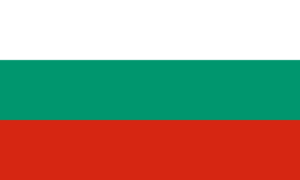History of Bulgaria:
The name Bulgaria comes from the Bulgarians who settled in the area around 200 AD. In the early days of the country, which is now Bulgaria, the area was settled by an ancient Thracian culture.
The first state of Bulgaria was founded in his 6th century. After that, the First Bulgarian Kingdom seized power under Emperor Simeon I from his 893 to his 927. This period is sometimes called the Golden Age of Bulgaria. It was a time of flourishing art, culture, education and literature. However, this era did not last very long, and neighboring countries and empires influenced Bulgaria for the next 1000 years.
The Byzantine Empire first appeared in his 1018 year. The Bulgarians pushed back the Byzantines, but the Mongols soon arrived, followed by the Ottomans. The Ottoman Empire will rule for over 500 years. It was not until the early 20th century that they were liberated from the Ottoman Empire.
Many wars followed, including the Balkan Wars, World War I, and World War II. After World War II, Bulgaria became a communist state and a satellite of the Soviet Union. With the collapse of the Soviet Union at the end of the 20th century, Bulgaria experienced economic hardship and social unrest. On January 1, 2007, Bulgaria became a member of the European Union.
Information about Bulgaria:
| Capital | Sofia |
| Population | 6,687,717 (Source: 2023 worldometer) |
| Major Cities | Sofia (capital), Plovdiv, Varna, Burgas, Russe |
| Borders | Romania to the north, Serbia and North Macedonia to the west, Greece and Turkey to the south, and the Black Sea to the east |
| Gross Domestic Product (GDP) | $89,040,398,406 (2022 worldometer) |
| Currency | lev (BGL) |
Flag of Bulgaria:
Bulgaria Economy Key Industries:
Bulgaria Major Industries: electricity, gas, water; food, beverages, tobacco; machinery and equipment, base metals, chemical products, coke, refined petroleum, nuclear fuel
Bulgaria Agricultural Products: vegetables, fruits, tobacco, wine, wheat, barley, sunflowers, sugar beets; livestock
Bulgaria Natural Resources: bauxite, copper, lead, zinc, coal, timber, arable land
Bulgaria Major Exports: clothing, footwear, iron and steel, machinery and equipment, fuels
Bulgaria Major Imports: machinery and equipment; metals and ores; chemicals and plastics; fuels, minerals, and raw materials
The Geography of Bulgaria:
Total Size of Bulgaria: 110,994 km2 (source: 2022 The world factbook)
Geographical Low Point of Bulgaria: Black Sea 0 m
Geographical High Point of Bulgaria: Musala 2,925 m
Climate of Bulgaria: Temperate; cold, damp winters; hot, dry summers
General Terrain of Bulgaria: mostly mountains with lowlands in north and southeast
World Region or Continent of Bulgaria: Europe
Geographical Coordinates: 43 00 N, 25 00 E
The People of Bulgaria & Culture
Bulgaria Government Type: parliamentary democracy
Bulgaria Nationality: Bulgarian(s)
Bulgaria National Holiday: Liberation Day, 3 March (1878)
Bulgaria Independence: 3 March 1878 (as an autonomous principality within the Ottoman Empire); 22 September 1908 (complete independence from the Ottoman Empire)
Bulgaria National Symbol: lion
Bulgaria National Anthem or Song: Mila Rodino (Dear Homeland)
Bulgaria Languages Spoken: Bulgarian 84.5%, Turkish 9.6%, Roma 4.1%, other and unspecified 1.8% (2001 census)
Bulgaria Religions: Bulgarian Orthodox 82.6%, Muslim 12.2%, other Christian 1.2%, other 4% (2001 census)
Interesting Facts about Bulgaria:
Bulgaria is the home of yogurt. Bulgarians call their milk “sour milk” and believe it will help them live longer.
Bulgaria is the world’s second largest exporter of rose oil, an ingredient in most perfumes.
Bulgarians shake their heads when they want to say yes and nod when they want to say no. It takes time to get used to this Bulgarian nod.
The national instrument of this country is the gajda, known as the bagpipe. At the time of this writing, Bulgaria has nine UNESCO World Heritage Sites.
Shopska, also known as Bulgarian salad, was voted the best European dish in a competition organized by the European Parliament.
Facebook founder Mark Zuckerberg has Bulgarian roots. He was named after his Bulgarian grandfather Marko.
The legendary Thracian singer Orpheus lived his life in ancient Bulgaria. Orpheus is the son of the river god Oeagros.
Rakia is an alcoholic beverage made from fermented pears, grapes, and apricots. This is the national drink of Bulgaria and is usually consumed with Shopska.
Here is his one of many interesting facts about Bulgarian culture. Bulgarians celebrate a unique holiday known as Baba Her Malta (Grandmother’s Procession) at the beginning of March each year. Locals exchange martenitsas, or tassels, made of white and red threads. The city of Kazanlak hosts an annual rose festival, where a girl is elected the ‘Queen of Roses’. Festivals include street parades, folklore concerts, art exhibits, wine tastings, exhibitions, and more.
His two largest mountain ranges in Bulgaria are the Balkans and the Rhodopes.
The medieval town of Bansko is a famous place for skiing.
The Rila Monastery in Bulgaria has a wooden cross with 140 minute scenes from the Bible. The largest of the 1,500 depicted figures is smaller than a grain of rice. It is just one of many interesting places in Bulgaria.
Bulgaria is her third most biodiverse country in Eastern Europe. Home to over 3,500 species of vascular plants and her nearly 415 species of birds.
In the 1980s, Bulgaria was the second largest wine producer in the world. Sofia, the capital of Bulgaria, has a motto: “Don’t stare.” In English, it means “to grow but not to age”.
The official language of this country is Bulgarian. It is written using the Cyrillic alphabet.
Another interesting fact about Bulgaria is that fire dancing (Nestinarstvo) is one of the oldest customs he in Bulgaria. It is still practiced today in some villages in the Strandzha Mountains.
Primary and secondary education in Bulgaria is funded by the state. The literacy rate in this country is 98 percent.


